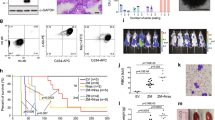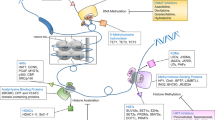Abstract
Growing evidence links abnormal epigenetic control to the development of hematological malignancies. Accordingly, inhibition of epigenetic regulators is emerging as a promising therapeutic strategy. The acetylation status of lysine residues in histone tails is one of a number of epigenetic post-translational modifications that alter DNA-templated processes, such as transcription, to facilitate malignant transformation. Although histone deacetylases are already being clinically targeted, the role of histone lysine acetyltransferases (KAT) in malignancy is less well characterized. We chose to study this question in the context of acute myeloid leukemia (AML), where, using in vitro and in vivo genetic ablation and knockdown experiments in murine models, we demonstrate a role for the epigenetic regulators CBP and p300 in the induction and maintenance of AML. Furthermore, using selective small molecule inhibitors of their lysine acetyltransferase activity, we validate CBP/p300 as therapeutic targets in vitro across a wide range of human AML subtypes. We proceed to show that growth retardation occurs through the induction of transcriptional changes that induce apoptosis and cell-cycle arrest in leukemia cells and finally demonstrate the efficacy of the KAT inhibitors in decreasing clonogenic growth of primary AML patient samples. Taken together, these data suggest that CBP/p300 are promising therapeutic targets across multiple subtypes in AML.
This is a preview of subscription content, access via your institution
Access options
Subscribe to this journal
Receive 50 print issues and online access
$259.00 per year
only $5.18 per issue
Buy this article
- Purchase on Springer Link
- Instant access to full article PDF
Prices may be subject to local taxes which are calculated during checkout






Similar content being viewed by others
References
Estey E, Dohner H . Acute myeloid leukaemia. Lancet 2006; 368: 1894–1907.
Cancer Genome Atlas Research Network. Genomic and epigenomic landscapes of adult de novo acute myeloid leukemia. N Engl J Med 2013; 368: 2059–2074.
Dawson MA, Kouzarides T, Huntly BJ . Targeting epigenetic readers in cancer. N Engl J Med 2012; 367: 647–657.
Blobel GA . CREB-binding protein and p300: molecular integrators of hematopoietic transcription. Blood 2000; 95: 745–755.
Gu W, Roeder RG . Activation of p53 sequence-specific DNA binding by acetylation of the p53 C-terminal domain. Cell 1997; 90: 595–606.
Bedford DC, Kasper LH, Fukuyama T, Brindle PK . Target gene context influences the transcriptional requirement for the KAT3 family of CBP and p300 histone acetyltransferases. Epigenetics 2010; 5: 9–15.
Rebel VI, Kung AL, Tanner EA, Yang H, Bronson RT, Livingston DM . Distinct roles for CREB-binding protein and p300 in hematopoietic stem cell self-renewal. Proc Natl Acad Sci USA 2002; 99: 14789–14794.
Chan WI, Hannah RL, Dawson MA, Pridans C, Foster D, Joshi A et al. The transcriptional coactivator Cbp regulates self-renewal and differentiation in adult hematopoietic stem cells. Mol Cell Biol 2011; 31: 5046–5060.
Pasqualucci L, Dominguez-Sola D, Chiarenza A, Fabbri G, Grunn A, Trifonov V et al. Inactivating mutations of acetyltransferase genes in B-cell lymphoma. Nature 2011; 471: 189–195.
Mullighan CG, Zhang J, Kasper LH, Lerach S, Payne-Turner D, Phillips LA et al. CREBBP mutations in relapsed acute lymphoblastic leukaemia. Nature 2011; 471: 235–239.
Holmfeldt L, Wei L, Diaz-Flores E, Walsh M, Zhang J, Ding L et al. The genomic landscape of hypodiploid acute lymphoblastic leukemia. Nat Genet 2013; 45: 242–252.
Roelfsema JH, Peters DJ . Rubinstein-Taybi syndrome: clinical and molecular overview. Expert Rev Mol Med 2007; 9: 1–16.
Kung AL, Rebel VI, Bronson RT, Ch'ng LE, Sieff CA, Livingston DM et al. Gene dose-dependent control of hematopoiesis and hematologic tumor suppression by CBP. Genes Dev 2000; 14: 272–277.
Taki T, Sako M, Tsuchida M, Hayashi Y . The t(11;16)(q23;p13) translocation in myelodysplastic syndrome fuses the MLL gene to the CBP gene. Blood 1997; 89: 3945–3950.
Ida K, Kitabayashi I, Taki T, Taniwaki M, Noro K, Yamamoto M et al. Adenoviral E1A-associated protein p300 is involved in acute myeloid leukemia with t(11;22)(q23;q13). Blood 1997; 90: 4699–4704.
Deguchi K, Ayton P, Carapeti M, Kutok J, Snyder C, Williams I et al. MOZ-TIF2-induced acute myeloid leukemia requires the MOZ nucleosome binding motif and TIF2-mediated recruitment of CBP. Cancer Cell 2003; 3: 259–271.
Kasper LH, Brindle PK, Schnabel CA, Pritchard CE, Cleary ML, van Deursen JM . CREB binding protein interacts with nucleoporin-specific FG repeats that activate transcription and mediate NUP98-HOXA9 oncogenicity. Mol Cell Biol 1999; 19: 764–776.
So CW, Cleary ML . MLL-AFX requires the transcriptional effector domains of AFX to transform myeloid progenitors and transdominantly interfere with forkhead protein function. Mol Cell Biol 2002; 22: 6542–6552.
Bayly R, Chuen L, Currie RA, Hyndman BD, Casselman R, Blobel GA et al. E2A-PBX1 interacts directly with the KIX domain of CBP/p300 in the induction of proliferation in primary hematopoietic cells. J Biol Chem 2004; 279: 55362–55371.
Payne SR, Kemp CJ . Tumor suppressor genetics. Carcinogenesis 2005; 26: 2031–2045.
Jemal A, Siegel R, Ward E, Hao Y, Xu J, Murray T et al. Cancer statistics, 2008. CA Cancer J Clin 2008; 58: 71–96.
Oki Y, Issa JP . Epigenetic mechanisms in AML - a target for therapy. Cancer Treat Res 2010; 145: 19–40.
Baljevic M, Park JH, Stein E, Douer D, Altman JK, Tallman MS . Curing all patients with acute promyelocytic leukemia: are we there yet? Hematol Oncol Clin North Am 2011; 25: 1215–1233 viii.
Huntly BJ, Shigematsu H, Deguchi K, Lee BH, Mizuno S, Duclos N et al. MOZ-TIF2, but not BCR-ABL, confers properties of leukemic stem cells to committed murine hematopoietic progenitors. Cancer Cell 2004; 6: 587–596.
Bowers EM, Yan G, Mukherjee C, Orry A, Wang L, Holbert MA et al. Virtual ligand screening of the p300/CBP histone acetyltransferase: identification of a selective small molecule inhibitor. Chem Biol 2010; 17: 471–482.
ENCODE Project Consortium. A user's guide to the encyclopedia of DNA elements (ENCODE). PLoS Biol 2011; 9: e1001046.
Walter RB, Appelbaum FR, Estey EH, Bernstein ID . Acute myeloid leukemia stem cells and CD33-targeted immunotherapy. Blood 2012; 119: 6198–6208.
Grunwald MR, Levis MJ . FLT3 inhibitors for acute myeloid leukemia: a review of their efficacy and mechanisms of resistance. Int J Hematol 2013; 97: 683–694.
Kimbrel EA, Lemieux ME, Xia X, Davis TN, Rebel VI, Kung AL . Systematic in vivo structure-function analysis of p300 in hematopoiesis. Blood 2009; 114: 4804–4812.
Allard S, Masson JY, Cote J . Chromatin remodeling and the maintenance of genome integrity. Biochim Biophys Acta 2004; 1677: 158–164.
Gang EJ, Hsieh YT, Pham J, Zhao Y, Nguyen C, Huantes S et al. Small-molecule inhibition of CBP/catenin interactions eliminates drug-resistant clones in acute lymphoblastic leukemia. Oncogene 2013; 33: 2169–2178.
Wang L, Gural A, Sun XJ, Zhao X, Perna F, Huang G et al. The leukemogenicity of AML1-ETO is dependent on site-specific lysine acetylation. Science 2011; 333: 765–769.
Gao XN, Lin J, Ning QY, Gao L, Yao YS, Zhou JH et al. A histone acetyltransferase p300 inhibitor C646 induces cell cycle arrest and apoptosis selectively in AML1-ETO-positive AML cells. PLoS One 2013; 8: e55481.
Dawson MA, Prinjha RK, Dittmann A, Giotopoulos G, Bantscheff M, Chan WI et al. Inhibition of BET recruitment to chromatin as an effective treatment for MLL-fusion leukaemia. Nature 2011; 478: 529–533.
Papaemmanuil E, Gerstung M, Malcovati L, Tauro S, Gundem G, Van Loo P et al. Clinical and biological implications of driver mutations in myelodysplastic syndromes. Blood 2013; 122: 3616–3627.
Ihaka R, Gentleman R . R: a language for data analysis and graphics. J Comput Graph Stat 1996; 5: 299–314.
Acknowledgements
Funding in the Huntly laboratory comes from Cancer Research UK, Leukemia Lymphoma Research, the Kay Kendal Leukemia Fund, the Leukemia lymphoma Society of America, the Wellcome Trust, The Medical Research Council and an NIHR Cambridge Biomedical Research Centre grant. Patient samples were processed in the Cambridge Blood and Stem Cell Biobank.
Author Contributions
BH, GG and W-IC designed the experiments, GG, W-IC, SJH, PG, AF and EP performed experiments. GG, WI-C, DR, EP, PC, BG and BH analyzed data. CC, JMVD and PAC provided critical reagents. BH oversaw the study. BH, GG and W-IC wrote and all authors reviewed the manuscript.
Author information
Authors and Affiliations
Corresponding author
Ethics declarations
Competing interests
PA Cole is a cofounder, equity holder and paid consultant for Acylin Therapeutics which is developing p300 HAT inhibitors.
Additional information
Supplementary Information accompanies this paper on the Oncogene website
Supplementary information
Rights and permissions
About this article
Cite this article
Giotopoulos, G., Chan, WI., Horton, S. et al. The epigenetic regulators CBP and p300 facilitate leukemogenesis and represent therapeutic targets in acute myeloid leukemia. Oncogene 35, 279–289 (2016). https://doi.org/10.1038/onc.2015.92
Received:
Revised:
Accepted:
Published:
Issue Date:
DOI: https://doi.org/10.1038/onc.2015.92
This article is cited by
-
Interplay between cofactors and transcription factors in hematopoiesis and hematological malignancies
Signal Transduction and Targeted Therapy (2021)
-
Identification of lysine acetylome in cervical cancer by label-free quantitative proteomics
Cancer Cell International (2020)
-
Garcinol inhibits esophageal cancer metastasis by suppressing the p300 and TGF-β1 signaling pathways
Acta Pharmacologica Sinica (2020)
-
ANP32A regulates histone H3 acetylation and promotes leukemogenesis
Leukemia (2018)
-
Peptidomimetic blockade of MYB in acute myeloid leukemia
Nature Communications (2018)



